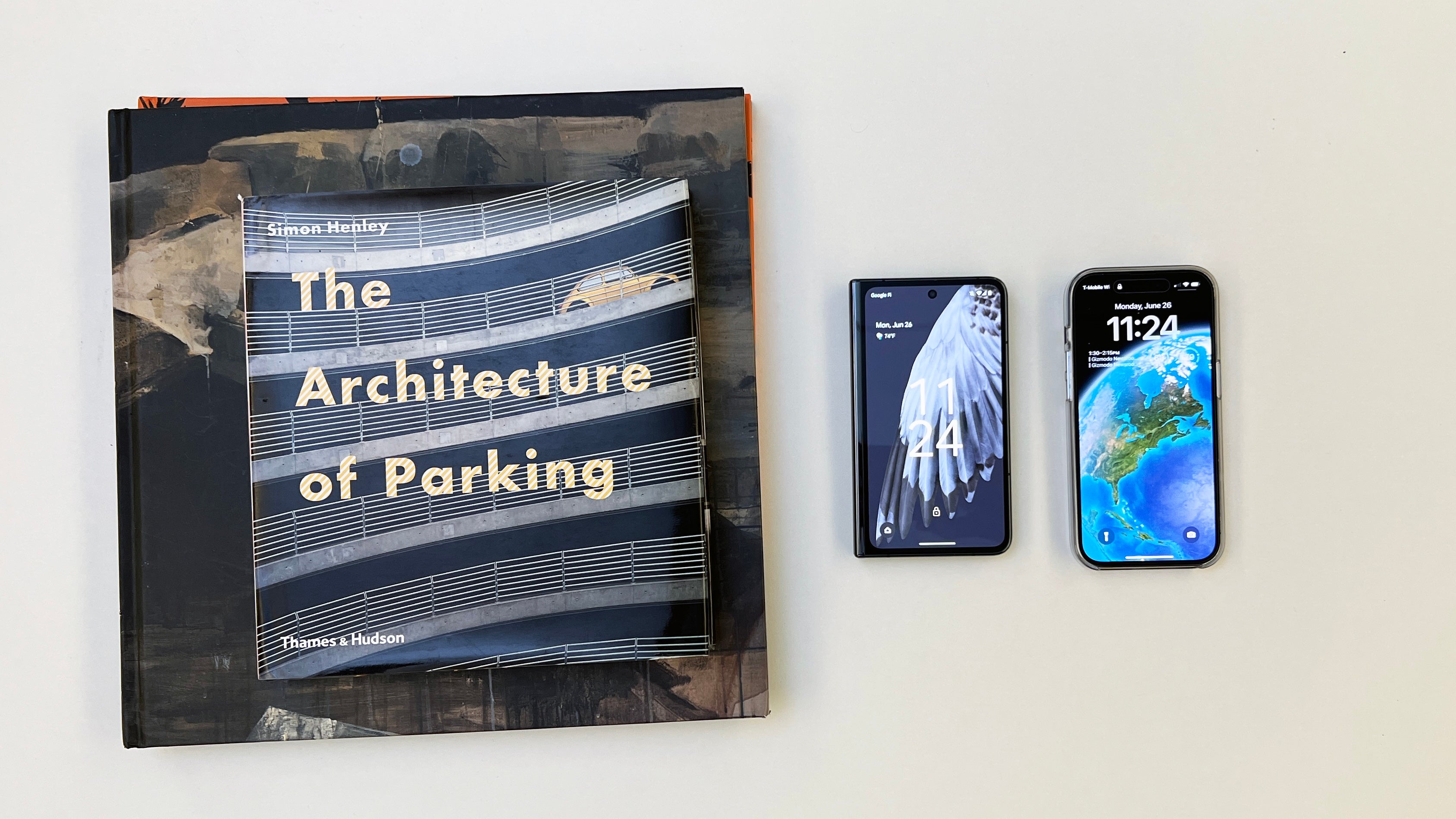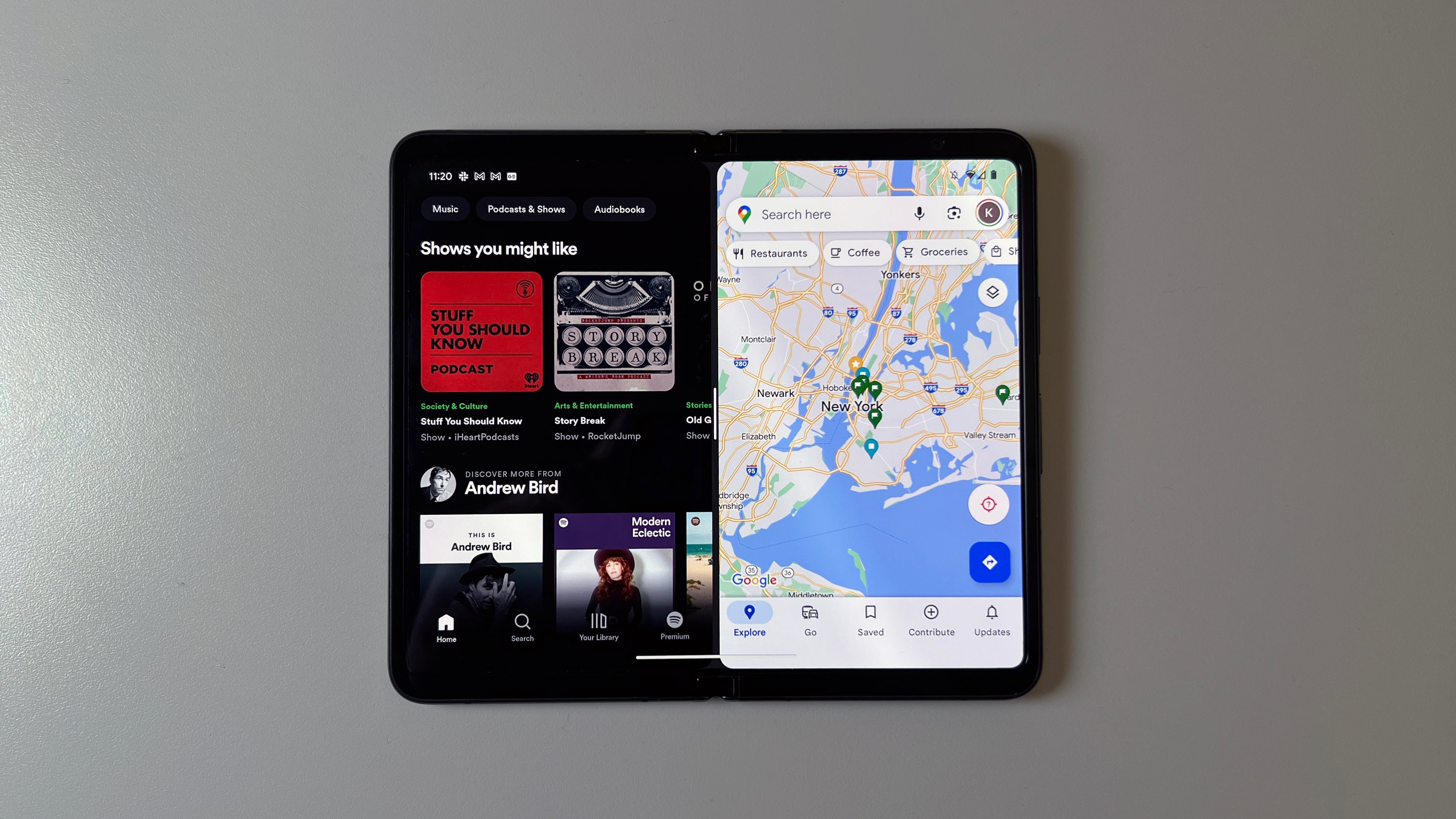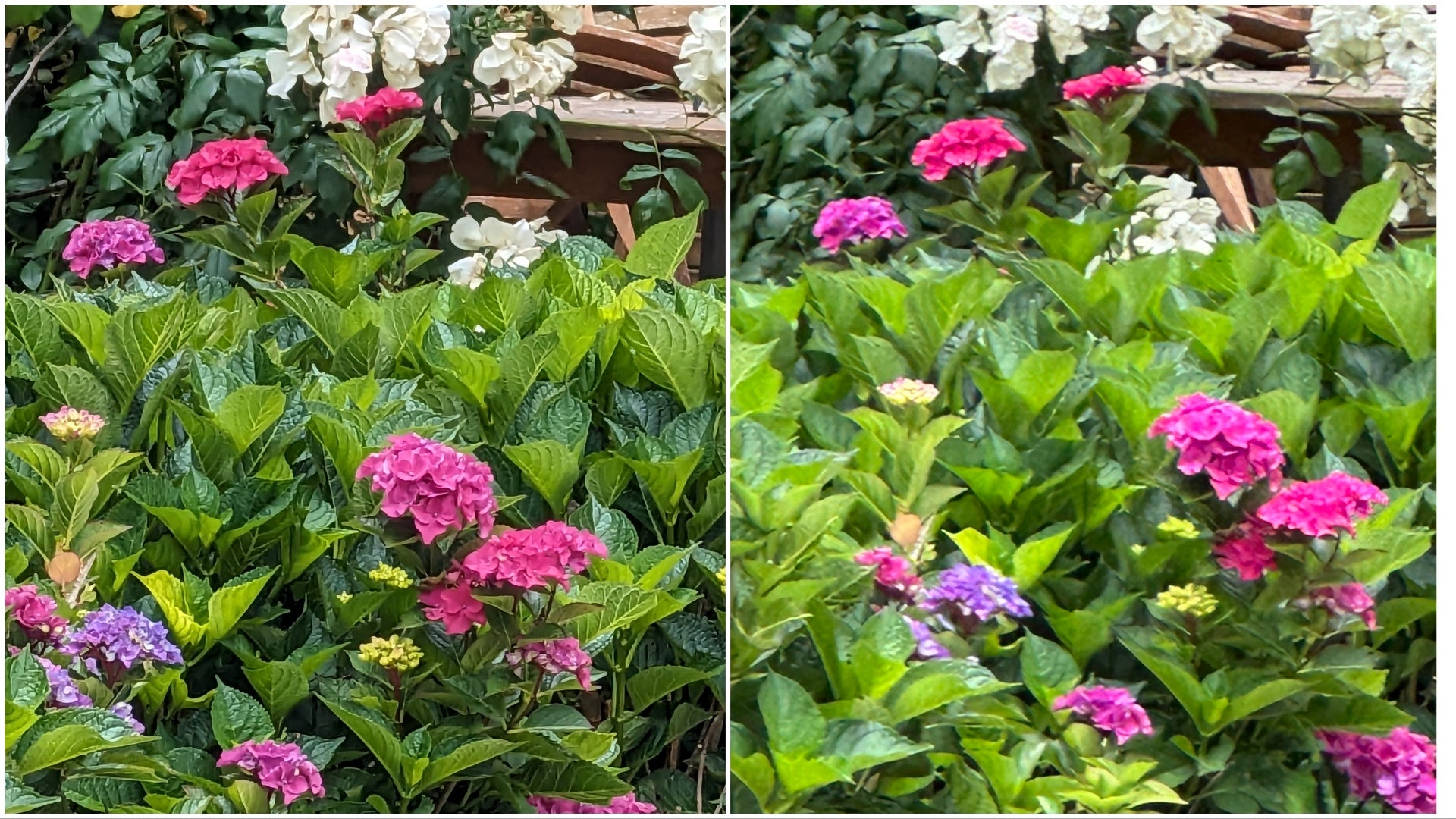After months (years, really) of speculation, rumours, and confirmation in the form of a tweet, the Google Pixel Fold was finally revealed last month. Unfortunately, though, it’s not coming to Australia – at least any time soon. Usually, we’d catch a review from our U.S. colleagues of a gadget that isn’t making its way down under and just not bother sharing it with you – but we thought this might be one you’d be keen to read, regardless. The rest of the review will continue as it was published, so get your FOMO ducks in line, and forgive the hyper-American nature of what you’re about to read.
I’ve long been sceptical of foldable phones. I’ve had to bite my tongue to stop myself going as far to call them an expensive gimmick. Then Google’s $US1,800 Pixel Fold comes into my life, and suddenly I’m enamoured by the thought of dual screens. Google’s entry into the foldables category is pitched as combining the Pixel design paradigm with a mini tablet. It also means Samsung’s Fold line now has to compete with a bruiser of its own size.
Is the Pixel Fold the thing that will bring flexible screens to the wider market? In one word: No. In two words: Not yet.
Google obviously wanted to bring the heat to Samsung for its first outing in the foldable market, but for every issue it fixes with past foldables, it stumbles over well-trodden ground. The Fold costs the same as Samsung’s Galaxy Z Fold 4, and while it might be more comfortable to hold, some features don’t quite match up.
Google Pixel Fold
WHAT IS IT?
Google's first foldable phone, with a full-size third screen on the back.
PRICE
$US1,800 for the 256 GB version and $US1,920 for the 512 GB version.
LIKE
The Pixel Fold feels sturdy, though we'd need extended use to confirm it will remain that way. The camera is the best on a foldable, and it has excellent dual screen functionality.
DISLIKE
The Fold does not fold completely flat, and the large centre crease is noticeable while watching videos. Unlike Samsung, Google has not had multiple generations to work out UI issues.
What Google has created is a luxury product that tries to — ahem — fold in the processing power, reliable format, and photo capabilities from the company’s top-of-the-line Pixel 7 Pro phones. It does indeed have features that make use of its foldability, yet the phone is often more cumbersome than its smaller, cheaper Pixel counterparts. Google also wants to win out on the survivability department, and it’s obviously hoping to make a squashable device sturdy enough it can survive hundreds of folds, if not the occasional “happy birthday to the ground.” For that safety, Google has to make sacrifices: The Fold has some of the largest bezels I’ve ever experienced on any modern device.
That’s not to say the Pixel Fold isn’t powerful. It’s using Google’s own Tensor G2 and the Titan M2 security coprocessor, which also powers the new Pixel Tablet, Pixel 7 and 7a. With 12 GB of LPDDR5 memory, it runs well, it runs fast, it runs flat(ish), but in the end there’s only so much screen a man like me can make use of to excuse its shortcomings, especially given how expensive it is.
Display size and features
Even though Google touts this as the “thinnest foldable phone,” the Pixel Fold feels like a hefty slab rather than a reliable writing slate. That’s due more to its weight than its footprint. It weighs 283.50 g, and without a case, it’s 0.5 inches thick. That’s smaller than the Samsung Galaxy Z Fold4, but with a case — and you should absolutely buy a case if you want the screen to have any hope of surviving a tumble — the phone still feels like a brick in the hand. Like other foldables, Google’s version won’t slip serenely into just any thin pocket on a pair of tight jeans.
The Pixel Fold’s front screen, available when the device is shut, is a relatively comfortable 5.8-inches. Some people might find this too small, and it’s certainly squatter and stouter than my iPhone 14 Pro, but it at least looks more like a regular phone when shut. If the Z Fold4 is the tall, regal elf with a long pedigree, then the Pixel Fold is the hardier, thicker dwarf suspiciously eyeing its Samsung cousin.

For somebody like me who lives in a cloud of perpetual dust, the best part of the Pixel Fold’s design is that it shuts almost completely closed, with only a small gap around the hinge. The action of unfolding it takes the slightest bit of extra effort, which for me was more satisfying than annoying. Still, you need two hands to open and close it. I will give Google this much, it certainly feels like a luxury phone product — until you open it and get into the nitty gritty of daily use.
The miniature tablet-sized panel is where things get wonky. Looking down at this extended 7.6-inch OLED display, one of the first things you’ll notice is the massive bezels surrounding the screen. This is to enclose the exposed steel hinges that facilitate the phone’s meaty folding action. Even with a nervous tick constantly unfolding and refolding the device, I haven’t spent nearly enough time to say whether the thick hinge makes up for the oversized bezels in survivability. Notably, like its Samsung cousins, the Fold is IPX8 rated for water resistance, meaning it can survive up to 3.2 feet of fresh water for half an hour.
The screen itself is high enough quality just with the naked eye, but it’s a 6:5 aspect ratio compared to the Z Fold4’s 23.1:9 ratio. The Fold’s running at 120Hz refresh rate and at 380 PPI, so you’re in for some sharp images.
Here’s the thing: the device does not go completely flat, even with a case surrounding the camera housing. Unfurled, one end of the device will sit slightly off a flat table. Inside, there’s a very noticeable crease in the centre that constantly catches the light. If I lay out the phone and swipe my finger across the screen from side to side, it rocks like a baby in a crib. In that way, it feels more like a book than a tablet.
It’s sized well enough that I can lay in bed and hold the phone with one hand while watching a video on YouTube or Netflix, but I can’t stand it when the glare of the crease interrupts my procrastinating. Samsung has spent several generations of foldables trying to minimise the crease to the size of a roadside gully, whereas Google has left a ravine in the middle of its highway.
Notably, the screen is slightly softer than the exterior screen, though I haven’t had any issues with scratches in my days of use. It’s got Gorilla Glass Victus covers on its screens, and in my few days with it, I didn’t experience any bubbling or scratches (which could also be thanks to the huge bezels). We’ll certainly dive into how it works after a few weeks or months of use, but for now, the Pixel Fold still feels solid.
The advantages of dual screens

Everything I do, I do with two screens. If I’m at work, I have my MacBook Air running connected to a 1,920 x 1,080 monitor. If it’s at home, I have my dual screen setup on my PC. If I’m sitting on the couch, I have my laptop and my phone sitting nearby, the latter of which controls my music or audiobook selection. I didn’t know it at first, but a dual-screen design for phones is a pretty significant quality of life upgrade for folks like me who crave the ability to run two apps at once.
At work, I’ve browsed for stories while keeping up with my company’s Slack channels. I can keep on top of Twitter while also DMing memes to friends on Instagram. The fact that the Fold’s screen doesn’t sit flat isn’t nearly as egregious when using two apps at once, especially when dancing back and forth between apps.
Google has made it easy to pop up the taskbar then drag different apps onto either side of the screen. Both apps then morph to fit the right proportions. You can also drag some elements from one app to another, like taking an image from Photos which you can then pull into an open texting app.
I also had some fun running the phone in its tent mode and tabletop mode. It’s like having a cute, little laptop available out of your pocket, though if you’re like me, a small 5.8-inch screen is no replacement for a laptop or TV. It’s certainly useful for doing video calls.
But if you really want a laptop, you could buy both a 13-inch MacBook Air and a standard Pixel 7 for less than the Pixel Fold.
Google is promising that there will be even more features that make use of all those screens. The upcoming release of Android 14 will also bring a Live Interpreter Mode. That app would make use of both the exterior and inner screens, and after a user reads or types in one language on the inside, the translation should be readable on the outside. Tabletop Mode should also receive new UI optimisations that let you pause and scroll to different parts of the video on the bottom screen. The changes are coming in August, though it’s a shame that such obvious functionality isn’t ready out the starting gate.
A UI with a learning curve
The Pixel Fold might look like every other Android screen, at least at first. Then, as you go through the phone setup, Google introduces you to different kinds of swipe-based controls than in previous iterations of its OS. Those expecting a regular Pixel experience should anticipate a small learning curve. First of all, the chin buttons aren’t available by default. I have to ask: with all that bezel space, you couldn’t fit in a simple back button?
Instead, the Fold relies on gesture controls that remind me more of iOS than Android. Instead of swiping up to find all active apps, you drag from the bottom and hold there. In order to go back within apps, you swipe from the right or left toward the centre of the screen. These changes make some sense since the controls work on both the smaller and larger screen, as well as individually for apps in dual screen mode.
You can switch to the classic chin button through settings, though you immediately see why Google defaulted to gesture-based controls. When the Pixel is unfolded, the a large portion of the bottom of the screen is taken up by an app task bar, plus the back and app buttons. I wish you could use a gesture control to bring up those buttons manually when in extended mode, so hopefully Google will iterate with time.
For somebody like me who used a Pixel for the last five years, there’s some whiplash, and I still have yet to find the control intuitive, especially trying to draw up the full app list. Tablet mode can use several keyboard settings, though only the split keys are really usable for typing with two hands. Even then, it takes a bit of getting used to seeing one half a keyboard separated from the other. Also, this means you can’t use swipe typing, which is what I usually use on mobile.
Camera and photo features

Google has long touted its phones as having the best cameras in the biz. For example, the Pixel 7 Pro showed that it could still dunk on Apple’s 48 MP iPhone 14 Pro. Note that the Pixel Fold has three sets of cameras to think about. The rear camera array includes a 48 MP sensor (compared to the Pixel 7 Pro’s 50 MP) and another ultrawide lens with 5x optical zoom and its 20X “Super Res Zoom.” That last feature was also available on the 7 Pro, and it adds some pixel replacement to beef up heavily zoomed photos.
I took the camera for a spin through my neighbourhood. It’s been cloudy in Brooklyn lately, though I can’t complain about the Pixel Fold’s image quality one bit. The colours are vibrant, and Google’s auto-focusing feature remains some of the best in mobile cameras. I compared some shots of flowers in my local community garden from my iPhone 14 Pro as well as to some pictures of a local church. I prefer Google’s more vibrant colours, and in Portrait Mode, Google still manages to make close-up objects pop.
But then you have to consider the foldability, and that added kickstand-like functionality does give it a leg up compared to other, standard phones. With the foldable screen, you can take 48 MP selfies with the touch of a button. You can prop it up on a table and take timed photos. Google phones have long had quality anti-shake technology, but being able to lie a camera flat on a surface does remove much of the headache.

I brought the Pixel Fold to sword fighting practice (yes, that’s a hobby of mine), and I have to say having a phone that can become its own kickstand for hands free shooting is definitely handy. I can set it and forget it for a while, and despite people jumping back and forth in and out of frame, it always keeps a good focus. Still, you could also buy a decent portable phone tripod for less than $US1,800 and stuff it in your backpack.
In some night shot comparisons outside my apartment window, the night sky is certainly brighter and a bit bluer on the Fold than on my iPhone 14, even with the same exposure time. I definitely prefer the Pixel to the iPhone for interior night shots.
Battery and power are about what you expect from a Pixel
Several of the apps Gizmodo would usually use to run benchmarks, including 3DMark and Geekbench 6, don’t yet support the Pixel Fold. We’re hoping to break out more facts and figures at a future date.
I used the browser-based JetStream2 benchmarking tool to rate how well the Fold performed under multiple web workloads. Higher numbers are better. I compared the Pixel Fold to my iPhone 14 Pro, both on the Chrome app. The Fold received an average score of 131, while the iPhone sat comfortable with an average of 286. For further comparison, a 2020 M1-powered MacBook Air hits around a 260.
Jetstream 2 (higher scores are better)
iPhone 14 Pro: 286
M1 MacBook Air: 260
Google Pixel Fold: 131
The Pixel Fold comes stock with a 4821 mAh battery promising “beyond 24-hour battery life.” It supports 300W of fast charging and wireless charging. In daily use, I found the battery would get to about 65% after eight hours of constant use at work. By the end of the night, it was usually sitting around 50%, so I could expect the device to last a full day as long as you’re not taking a lot of video or watching 15 hours of Netflix straight. We’re hoping to do a full battery stress test soon.
Who should buy the Pixel Fold?

I can’t tell most people to rush out and grab the Pixel Fold right now, but I can say I did enjoy my time on the phone. Would I use this as my daily device? For me, it’s too cumbersome for how I use my phone, and as fun as dual screens are, I already own too many screens to add another set.
For the same $US1,800, I might buy another top-of-the-line phone with a solid camera, perhaps Google’s own Pixel 7 Pro, and still have money left over for a surprise trip to Alaska to photograph its receding glacial vistas.
The Pixel Fold is good enough as a first outing. Unfortunately, it’s not the revolutionary product that foldables need to convince an everyday user, perhaps not even the most dedicated Pixel user.
Instead, Google has turned its Pixel 7 Pro into a foldable with two screens, given it a near-identical camera, added a few extra bells and whistles, and upped its price by $US1,000. If that sounds good to you, then go ahead and get cracking. If you’re set on a foldable that’s not a flip phone, and you want the best out there, you should wait to see what Samsung or even OnePlus have in store later this year before making a final decision. That wait also might also give Google enough time to bring in promised features like Live Translate and perhaps nail down some of its current UI issues.
